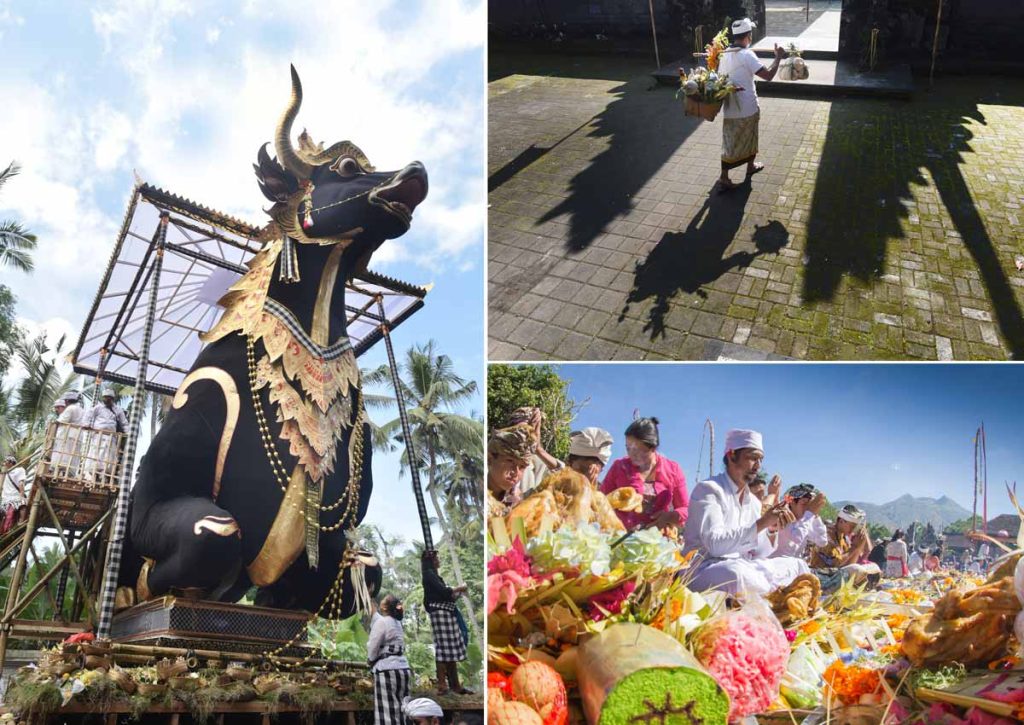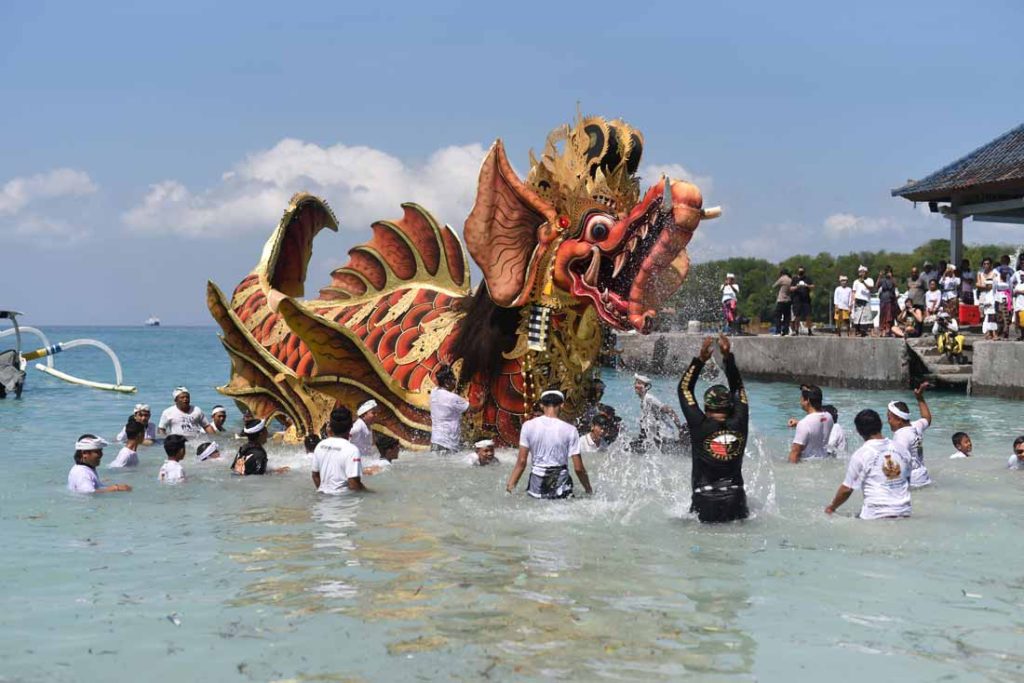NOW! Bali Contributor, Richard Horstman, reviews a new book released by Balinese photographer, Ida Bagus Putra Adnyana, titled ‘Ancient Spirit of Bali – the great richness of religious traditions’:-
Western culture views humans as separate from and superior to the nonhuman world. Balinese culture on the contrary offers profound insight into our links to nature. And it does so best in the visual language of rituals.
For readers eager to delve deeper into Balinese culture, ‘Ancient Spirit of Bali; the great richness of religious traditions’, – a 212 book by photographer Ida Bagus Putra Adnyana, provides exceptional documentation on the rituals of the island, further enhanced with explanations given by cultural wordsmith Garret Kam, a noted specialist on Bali. Their combined investigation ventures well beyond the normative borders of enquiry to reveal traditions rarely witnessed by most Balinese.

Balinese religion is a multifaceted merging of animism, ancestor worship and Hindu-Buddhism that constantly integrates novel elements in an ever-fluid reproduction of itself. Consequently, its rituals are immediately exotic and mysterious. Its pageantry is renowned, with some aspects well-known to international tourism. Yet, there is a wealth of lesser-known ritual practices. It is these practices that make the core of the new book.
The volume, published in hardcover by MPB Publishing in early 2022, features over two hundred colourful digital images. Some of which you may know since the award-winning photographer has been widely exhibited nationally and internationally, and his works feature in numerous book projects and magazines. Ida Bagus Putra Adnyana, alias Gustra, began documenting his culture over forty years ago.

Born in Denpasar in 1958 into the priestly Brahmana caste, Gustra’s cultural learnings first came via his father, a specialist in the sacred magical drawings, rerajahan. His challenge was to perfect the many designs encompassing symbols, script and pictures required to empower the white cotton shrouds adorning the deceased’s body in preparation for cremation. Gustra learned the skills so much that he soon dreamed of becoming an artist. However, his father coerced him into studying law. He did so until, in his early twenties, he was gifted his first camera. It changed his life. He has ever since been capturing and storing images. Most about Bali, constituting what is undoubtedly one of the richest collections in the world.
In ‘Ancient Spirit of Bali’, Gustra classifies the rituals in seven categories. Most of his groundwork in compiling the images occurred in the remote mountainous regions of north and eastern Bali, in the Karangasem regency. The book also highlights fertility ceremonies and offerings of the Bali Aga people in the Tenganan and Truyan villages: the communities that resisted the Javanisation brought about by the Majapahit invasion of 1341. The fantastic forms in which the offerings take shape and the ceremonial costumes boggle the mind. They are a testament to extraordinary creativity made possible only through the gods’ intervention.
What distinguishes this book from other documentations of Balinese rites and rituals is that Gustra has unique experience being a custodian of exclusive knowledge, passed down through his high-caste Brahmana lineage. He accesses information about events, allowing him direct admission to the most sacred Balinese traditions.

‘Ancient Spirit of Bali – the great richness of religious traditions’ chapters begin at the source of life, in ‘Holy Water – Flower Power – Purifying Flames’. Next follows ‘Spiritual Orientation of Mount Agung’, ‘Agricultural Rites’, ‘Sacred Masks’, ‘Rejang and Baris Dances’, ‘Back to Nature’ and culminating with ‘Rituals Before Saka New Year’. Each chapter is accompanied by comments from Hawaiian-born Garret Kam, a highly knowledgeable cultural observer. Kam received a Fullbright grant in 1987 to study Balinese rituals. He has since curated numerous national and international exhibitions on Balinese culture and written multiple articles, catalogue essays and books.
Idiosyncrasies of ancestral lineage, legends, folklore, history, mythology and religion inform the descriptive prose. Kam emphasises the distinctiveness of these century-old traditions that may be accounted to the people’s remarkable preservation of ancient traditions before the coming influences of the East Javanese Majapahit empire. When describing the most important female dance, the Rejang, Kam reveals that many of the dancer’s headdresses adorned with stunning flowers are similar to those worn in parts of Polynesia.
A fascinating double-spread image illustrates pages 154-155: beautifully dressed Rejang dancers, holding onto their leading counterparts’ white sash, circumnavigating an enormous rice flour figure of Yamaraja, the Hindu god of the underworld. Kam notes that after completing their performance, the audience rushes to collect the powdered rice with earth to treat skin diseases. This one-of-a-kind ritual merges religion, dance, installation art and traditional healing.
One of the oldest sacred mask traditions and rarely performed rituals of Trunyan is the barong brutuk fertility performance. The dancers adorn an unusually photogenic costume, with opposing aesthetics to the customary magnificently detailed ritual attire, featuring dried banana leaves and simple primitive masks. Another rite pictures a performer wearing a gold mask believed to date from the 14th-century East Javanese Majapahit kingdom. Underlining the significance of Gustra’s cultural endeavour is the image of the topeng dedari dance performed by two pre-pubescent girls. It depicts a cleansing ritual last performed 200 years ago and was done again in Sukawati during the pandemic to cleanse and harmonise the universe.

Bringing together such a compilation of images captured over a 20-year period, some taken during the pandemic, into one coherent photographic essay is an extraordinary feat of dedication. Gustra’s acute eye and sensitivity immortalise irreplaceable snapshots in time and warrant the highest praise. The images and text document alchemic customs transforming energies of the sacred elements of fire, water, wind, earth and ether with other powers to procreate and sustain life.
Essential for cultural connoisseurs and the curious, the book grants windows of deep knowledge over an extraordinarily visual culture. It endorses the role of the Balinese as proud custodians of a magnificent culture with an inclusive universal bent, admired by outsiders worldwide. Their dynamic cultural expressions of creativity are a unique gift to the global community.
The book furthermore confirms the success of the Balinese essential cultural endeavour: living in unison with nature and the cosmos. They do it through art in rites, and Gustra conveys it better than anyone, Balinese and non-Balinese, before him. Gustra has arguably the most extensive visual documentation on Bali in the world (12 terabytes!) and is of the highest quality. Museums should compete with one another to present them in their collections
‘Ancient Spirit of Bali’ will be available in Ganesha Bookshop, Ubud; Titian Art Space, Biji World, Mas – Ubud; or enquire directly on Instagram @ib_putra_adnyana.









